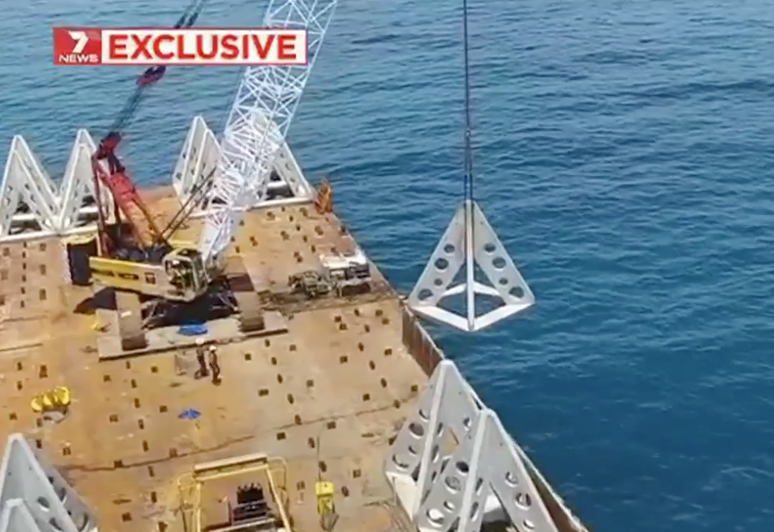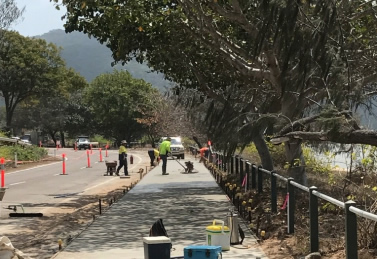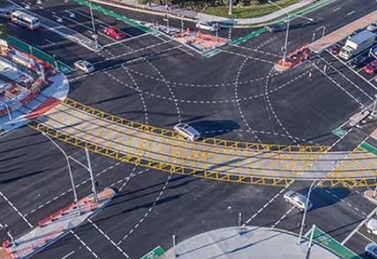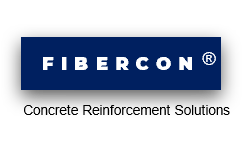FAQ Installation
Can Steel Fibres replace two layers of wire mesh in a floor slab?
In ground-bearing industrial floor slabs, common design practice occasionally dictates using two mesh layers. However, this steel is not acting in a structural capacity and can therefore be readily be replaced with Fibercon steel fibre reinforcement.
How are the fibres added to the concrete?
Fibres can be added at the batching plant by depositing onto an aggregate conveyor. Product can also be added by gantry or lightweight conveyor directly into the back of a transit mixer on site.
Don’t Steel Fibres “ball up” when mixing?
Homogeneous, trouble-free mixing depends on the fibre product’s aspect ratio – the ratio of length to diameter. If this number exceeds 55, the risk of fibres bunching together increases. Special packaging methods and/or dispensing machinery might then become necessary. But if the aspect ratio falls below this critical range, fibres can be added directly into the mix at virtually any stage – without fear of balling.
The fibres are made from mild steel – what about rusting?
The relative density of Steel is 7.8 and concrete mortar’s is about 2.4 When concrete is vibrated, fibres begin to align themselves in the top layer of laitance. Subsequent operations such as floating and trowelling further embed the fibres, so the number of fibres exposed at the surface of a finished installation is minimal. If subjected to conditions that promote corrosion, however, these fibres will rust, but will almost certainly not create a cosmetic problem. In circumstances where finish is critical, such as in architectural panels incorporating white OPC, stainless steel fibres are available.
Why doesn’t rusting lead to other problems?
The small size of individual steel fibres prevents a build up of expansion stresses during the corrosion process. The discontinuous nature of steel fibre reinforcement also effectively eliminates galvanic corrosion. Hence, concrete spalling and bursting does not occur. Finally, past studies of structures like bridge decks conclusively prove that fibre corrosion only occurs to the depth of the concrete’s carbonation.
Can Steel Fibre Reinforced concrete (“SFRC”) be textured?
Yes. Any conventional method can be used – although the use of hessian drag is not recommended. The heavier the texture, the more the fibres will be pulled from the surface. Again, the presence of these fibres will not pose any appearance or safety problem. Successful installations throughout the world – including roads and bridges – bear testimony to this.
Can Steel Fibre reinforcement be used in the presence of a wire guidance system?
Again, since steel fibre reinforcement is “discontinuous”, it does not interfere with wire guidance systems.
Unlike conventional reinforcement, no minimum cover is required.
Do Steel Fibres affect the slump of concrete?
Adding steel fibres, particularly at higher concentrations, will give rise to an apparent loss as measured by the slump test.
This results from fibre interlocking – which, when energy is applied, will align and allow concrete to flow more readily.
Generally, it is recommended that the base slump of concrete without fibre is 25-50mm greater than the final desired target. This is normally achieved by incorporating a small quantity of (super) plasticizer.
Can SFRC be pumped?
Fibercon SFRC can be readily pumped – providing, as with conventional concrete that the base mix contains sufficient fines to prevent segregation.
Can SFRC be placed and finished using conventional techniques?
Yes. Use of standard construction methods will yield excellent results. Steel fibre reinforcement also offers a whole new dimension to modern large placement methods of floor construction – such as Laser Screed technology – as well as to more conventional techniques.
What about joint detailing?
If using long bay construction methods, the longitudinal joints would be tied using dowels, as per conventional design. Transverse joints are typically saw-cut induced to 1/3 the slabs’ depth. Cutting should take place as early a possible – i.e., within 24 hours of pouring. Spacing between joints not only depends on the incorporation of steel fibres, but also on other considerations – like concrete shrinkable characteristics and the quality of sub-base preparation. Hence, joints will typically be spaced at between 6m and 12m centers, normally to coincide with columns or other intrusions.
The length-to-width ratio of panels should not exceed 1:1.5.
Construction of “jointless” floors – heavily reinforced slabs cast in bays to 2,000m2 is also increasingly popular. There is normally a compromise between number of joints, joint openings and cracking risks. The most suitable jointing regime should be assessed on a case-by-case basis.
Application
Save Time & Money With FIBERCON. We will engineer your solution- Leader in Steel and Macro Synthetic Fibres
- Custom fibre designs and packaging available
- Excellent crack control
- Superior installation performance
- Unequaled cost-effectiveness
- No handling or finishing problems
- Variety of standard types and sizes available
- Engineering and design assistance available...
Case Studies

FIBERCON fibres were chosen for Stradbroke Island artificial reef

Magnetic Island Walkway protected against salt corrosion

FIBERCON MP47 was chosen for Gold Coast Light Rail Project
Subscribe to our Newsletter
Keep up to date with the latest on our product developement and what’s new in the industry






